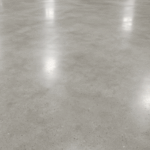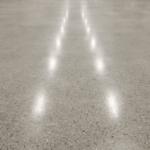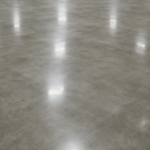Cement screed: The comprehensive guide for builders - from costs to drying time
What is cement screed? A simple explanation
Cementitious screed, often abbreviated to the standard term "CT screed", is basically a special mortar that is applied as a smooth and load-bearing layer on the unfinished floor or an insulating layer. It creates the necessary level surface on which tiles, parquet, laminate or carpet can later be laid.The composition: What is CT screed made of?
The recipe is classic and tried and tested. Cement screed consists of three main components:- Cement: The binder that gives the screed its strength.
- Aggregate: Usually sand or gravel in a defined grain size.
- Water: Is required to start the chemical reaction (hydration) of the cement, which leads to hardening.
The key functions of screed
A professionally laid cement screed fulfills several important tasks at the same time:- Load distribution: It distributes loads (e.g. from heavy furniture) evenly over the underlying insulation layer.
- Height compensation: It compensates for unevenness in the unfinished floor and brings the floor to the desired final height.
- The basis for floor coverings: It creates the absolutely even and stable surface that is essential for a professional installation of the final floor covering.
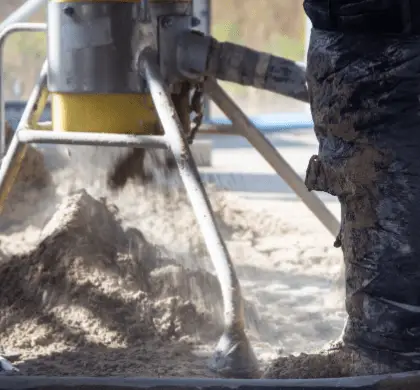
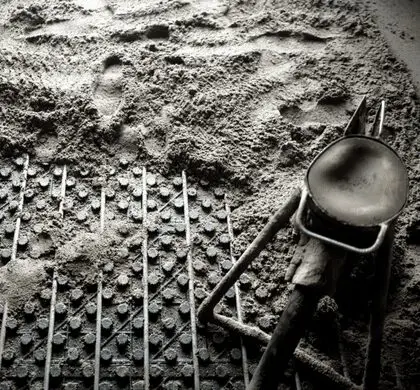
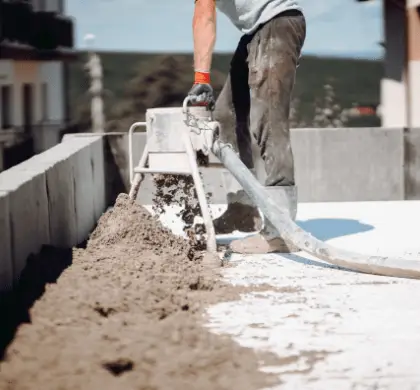
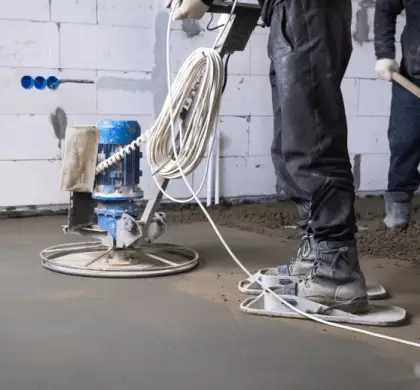
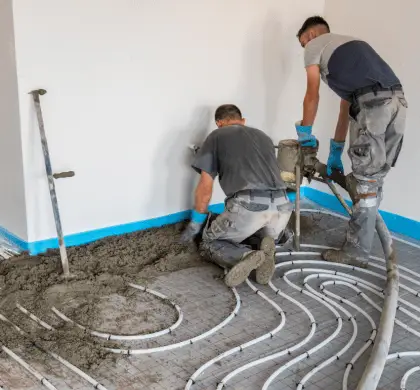
The unbeatable advantages of cement screed
Cement screed is the classic choice for a reason. Its properties make it the ideal choice for most construction and renovation projects.
- Robustness and durability: Once hardened, cement screed is extremely pressure-resistant and durable. It forms a foundation that literally lasts for generations.
- Moisture resistance: Unlike other types of screed (such as calcium sulphate screed), cement screed is naturally insensitive to moisture. This makes it the first choice for bathrooms, kitchens, cellars and garages.
- Versatility: Whether tiles, natural stone, parquet or carpet - cement screed is suitable as a substrate for almost any conceivable floor covering.
- Value for money: As a rule, cement screed is one of the most cost-effective screed variants.
Honest & transparent: the disadvantages and challenges of cement screed
Where there is light, there is also shadow. To make an informed decision, you also need to know the challenges. The crucial point is: there is a professional solution for every challenge. An experienced specialist company like us plans for these from the outset. Here is a transparent overview of the potential challenges and how we solve them for you in practice:
| The challenge | Solution / expert tip from a specialist company |
|---|---|
| Long drying time | The drying time must be realistically planned into the construction schedule. For projects under time pressure, we can use tested rapid screed additives that shorten the readiness for covering to just a few days. |
| Risk of cracking | The risk is reduced to a minimum by the professional installation of expansion joints, the correct screed mixture and a controlled drying climate (no draughts!). |
| High dead weight | A structural analysis check is essential, especially when renovating old buildings. We assess the conditions on site and, if necessary, consult a structural engineer to ensure safety. |
Are you unsure which type of screed is right for your project or how you can overcome these challenges? Our experts will be happy to advise you without obligation and work with you to find the best solution.
Cement screed on underfloor heating: the perfect combination?
Yes, cement screed is ideal for underfloor heating. Its high density ensures that it absorbs the heat from the heating pipes excellently, stores it and releases it evenly into the room. It is important that it is laid professionally:
- The heating pipes must be completely enclosed by the screed.
- Special additives are often added to the screed to improve thermal conductivity and reduce stresses.
- Before laying the floor covering, it is essential to carry out a standardized heating protocol in order to slowly acclimatize the screed to the thermal load and avoid stress cracks.
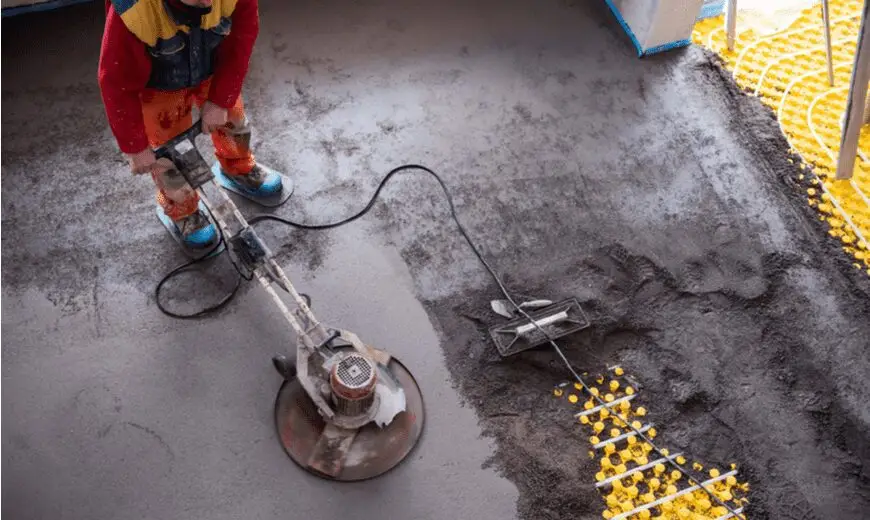
Costs for cement screed: What should you expect per m²?
One of the most important questions for builders. To give you a clear and transparent overview, we have broken down the typical cost factors. Expect costs of between 25 and 45 euros per square meter for a pure cement screed including installation.
Here is a more detailed breakdown of possible cost items:
| Cost factor | Description / guide value per m² |
|---|---|
| Standard cement screed (material & installation) | approx. 25 € - 45 € |
| Addition: Quick-drying accelerator | + approx. 5 € - 10 € |
| Addition: Compensation for underfloor heating | + approx. 2 € - 5 € |
| Insulation / sealing (if necessary) | Costs highly dependent on material and requirements |
| Construction site equipment / approach | Often included as a package in the overall offer |
Concrete cost example (120 m² new build):
For a standard cement screed without special additives, you can roughly calculate:
120 m² x 30 €/m² (average guideline value) = 3,600 €
Please note that these are approximate values. For an exact quote tailored to your project, an on-site inspection is essential.
The right structure: This is what the layer sequence with cement screed looks like
To understand the function, it is helpful to know the typical structure from bottom to top:
- Floor slab: The load-bearing concrete ceiling of the building.
- Sealing (optional): If required, a layer against rising damp.
- Insulation: Thermal and/or impact sound insulation. Pipes (electricity, water, heating) are also laid here.
- Separating layer: Usually a PE film that separates the screed from the insulation.
- Cement screed: Usually 4-7 cm thick.
- Flooring: tiles, parquet etc.
The most critical phase: Understanding the drying time of cement screed
Patience is the key to success here. A common mistake we see in practice is the desire to speed up the construction process and cover the screed too early. This can lead to serious damage to the floor covering later on.
The difference between "accessible" and "ready for occupancy"
- Can be walked on: The screed can be carefully walked on after approx. 2-3 days.
- Ready for covering: The screed has reached the necessary residual moisture to lay the final floor covering. Only now is it "dry" in the technical sense.
Guide values for drying time according to DIN standard
The following table gives you a good idea of the usual waiting times until the floor is ready for covering under standard conditions (20°C and 50% relative humidity).
| Screed thickness | Approximate minimum drying time until ready for covering |
|---|---|
| 4 cm | approx. 4 weeks |
| 5 cm | approx. 6 weeks |
| 6 cm | approx. 8 weeks |
| 7 cm | approx. 10 weeks |
Important note: These are theoretical guide values. The actual drying time depends heavily on temperature, humidity and ventilation. Final approval for laying the floor covering may only be given after a professional CM moisture measurement by a specialist.
Avoid common mistakes: Insider tips from a specialist company
A perfect screed result depends on the expertise of the craftsman. Pay attention to these points or leave it directly to the professional.
Mistake #1: Laying the screed too early
This is the most common and most expensive source of error. Residual moisture in the screed can lead to mold growth, deformation of parquet or detachment of tile adhesive. Always rely on a professional CM measurement!
Error #2: Incorrect ventilation and heating during drying
Too much draught or too fast heat removes water from the surface too quickly. The result: cupping (bulging of the edges) and cracks.
Mistake #3: Saving at the wrong end - the choice of craftsman
A cheap quote can quickly become expensive if repairs or even a complete renovation of the screed become necessary later on. Rely on a certified specialist company with proven experience and good references. [Suggested internal link: Take a look at our reference projects here].
Conclusion: Is cement screed the right decision for you?
Cement screed is a proven, robust and versatile all-rounder. If you are looking for a hard-wearing and durable substrate for your building project and can allow for the necessary drying time in the construction process, it is the best and most economical choice in the vast majority of cases. Its advantages far outweigh its disadvantages, provided it is laid by an experienced professional.
Do you have a specific project and want a reliable foundation for your home?
We will provide you with a transparent and fair offer that is tailored precisely to your needs. Contact us for a free and non-binding initial consultation.
Frequently asked questions (FAQ) about cement screed
The cost of cement screed, including professional installation, is typically between 25 and 45 euros per square meter. The exact price depends on the thickness of the screed, the size of the area and the conditions on site.
The drying time until "ready for covering" takes several weeks. A rule of thumb is: 1 week per cm thickness for the first 4 cm, then 2 weeks per additional cm. For a thickness of 6 cm, this means around 8 weeks. Only a professional CM measurement provides final certainty.
Cement screed is a universal substrate and is suitable for almost all floor coverings, including tiles, natural stone, parquet, laminate, vinyl and carpet.
Theoretically yes, but this is strongly discouraged. Errors in mixing, processing or assessing drying can lead to expensive consequential damage to the entire floor structure. Installation should always be left to an experienced specialist company.
